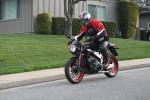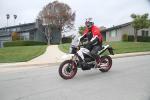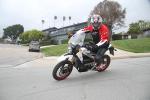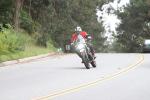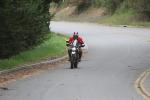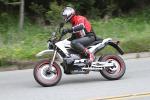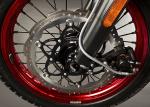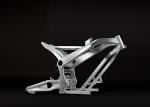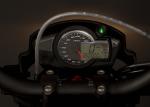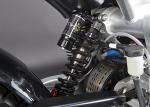Zero Electric Motorcycles 2011
By Kevin Ash - 25/05/2011
The first electric motorcycles haven‘t come, as you might have expected, from mainstream manufacturers adding them to their existing ranges of bikes.
Instead a number of small, independent companies have been started up by entrepreneurs to specialise in their design and production. There are several Chinese-made electric scooters, some with dire quality and very poor performance, but the first more serious electric motorcycles are only just making an appearance.

One of the most promising companies is based in Santa Cruz, California. Zero has produced a completely revamped range of machines for 2011, and I‘ll look at the off-road versions another time as they serve a very different and interesting purpose, but for now I‘ll concentrate on two road machines, the S and the DS.
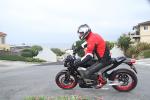
These have come a long way from earlier Zeros, which used to have something of a lash-up feel, more like bicycles with electric motors fitted, but the 2011 models are very much proper motorcycles. The DS is essentially a trail bike version of the S, using the same major components but with higher suspension, dual-purpose tyres, a high-rise front mudguard and other minor detail differences. This suits taller riders better as the S feels a little too small if you‘re much above average height, but with either machine, swinging a leg over the narrow saddle and grabbing the bars has much the same feel as any lightweight motorcycle - the overall mass is a svelte 297lb (135kg).

Things get rather different from this point. Turning the ‘ignition‘ key brings the electronics and LCD dash to life, and if you‘ve had the Zero plugged in, the battery charge level ironically labelled with a petrol pump symbol will show full. Then comes the weird bit: no clutch, no gears, no sound, just turn the twistgrip (it‘s not a throttle anymore...) and the Zero surges forward in near silence. The response is a little soft, but not very different to a petrol engine, except the only sounds you get are a few very quiet whines and whirrs. There‘s not even the buzz of a chain over sprockets from the transmission as these new street Zeros use belt drive, which like the electric motor needs no maintenance.

The performance is good, a little better than a typical 125cc petrol motorcycle, especially driving off from stationary, and the rest of the chassis works pretty well too. The suspension is quite firm but well balanced front to rear, although the taller DS version can feel edgy and close to throwing a wobble or two when cranked over on a bumpier bend. It made me a little nervous at times, although the very light weight means it will always be kicked about on anything but perfectly smooth surfaces anyway. I‘d like to see the geometry biased more towards stability though, there‘s no need on something this light to have especially edgy steering.

What is very encouraging is that the D and DS both are little different in most respects to riding a conventional small motorcycle. It takes a little time to get used to the lack of clutch or sound, especially when stopping and starting, otherwise despite these being so utterly different from normal bikes, and rather exciting for that, in fact there‘s little of interest to report. Which when you think about it, is as it should be.

Where your habits do have to change radically is at ‘refuelling‘ time. This comes very soon, in real life riding as early as 30 miles or so, although Zero claims more than 40 miles. I should report too that on our ride the charge meter was suggesting we‘d run out of juice at little more than 20 miles, in perfectly normal urban riding. Zero says this is because the bikes are new and the electronics need to learn the system and the riding style before the gauge becomes more accurate, and until then it‘s deliberately very pessimistic to make sure you‘re not stranded. Sounds perfectly plausible but I had no way of confirming this independently.
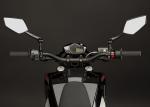
But replenishing is the same: rather than a four minute tank fill-up, you now need to plug the Zero in (a domestic 13 amp socket will do) and leave it for four hours. This can be reduced to just over two hours if you spend an extra £1,000 on the quick charge option, but it‘s still hardly in the same league as your local Shell garage, and a 125cc motorcycle might cover 150 miles and sometimes much more before demanding more fuel.
Then again, if you‘re planning only ever on commuting on the Zero (and it‘s rated in the same licence class as a learner legal 125) and ride, say, 15-20 miles each way to work, this bike could easily replace a petrol machine, as long as you remember to recharge it at each end of the journey. There‘s no topping up half way...
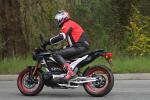
It‘s certainly cheaper to run, with each recharge costing around 50p, or £1.70 for 100 miles compared with £5.90 at current prices for a 100mpg motorcycle. But you won‘t be saving money as the S costs £8,295 and the DS £8,595, and the UK‘s £5,000 grant for electric cars hasn‘t been extended to motorcycles. Compare that with the £2,420 the excellent 115mpg Honda CBF125 costs and you really have to be committed to electrics to opt for the Zero.
The Zero will never catch up in economic terms. You‘d only recoup the price difference and start getting a return after 140,000 miles (which would demand more than two continuous years of recharging time), and that‘s forgetting that the battery is expected to last for about 70,000 miles, and a new one costs £2,500. Okay, a CBF125 needs more regular servicing, but not that much...

Even the green credentials are questionable. In the UK around 75 per cent of our electricity is generated by coal and gas, and inefficiencies in transmission from power station to Zero battery are a significant waste, while the lithium battery loses charge constantly when not in use, like a fuel tank with a continuous small leak (but less dangerous!). The Environmental Transport Association has calculated that an electric car is currently responsible for 106 grams of CO2 per kilometre, on a par with a modern small car (with better performance), so while they‘re good, they‘re still in the same ball park as petrol and diesel equivalents.
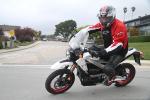
Another study suggests an electric car produces 1.2 times as much CO2 as a small turbodiesel, while the Carbon Trust says UK electricity production is responsible for 544 grams of CO2 per kilowatt hour. With the Zero covering 50km from its nominal 3.9kWh battery, that‘s 42 grams of CO2 per km, without accounting for the natural battery discharge when it‘s not in use.
At best then, you might be responsible for some reduction in CO2 emissions, but never mind the name of the company, they‘re far from zero, and it‘s difficult to see not only why you should take the electric route just yet, but that this really does point to the future. Even so, within those parameters, the Zero S and DS present the best case yet, and unlike electric cars, these could be a direct replacement for their petroleum equivalents, as the limitations are manageable without imposing on the typical useage.
Specifications
Model tested: Zero S and DS
Price: £8,295on the road (DS, £8,595)
Available: now
Engine: DC axial flux permanent magnet
Power: n/a
Torque: n/a
Economy: 7.5 miles per kWh approx
Tank/Range: 4.4kWh max, 3.9kWh nominal/ 43 miles EPA UDDS
Transmission: Direct, belt final drive
Chassis: Aluminium twin spar
Seat height: 32.8in (832mm) DS 35.8in (908mm)
Wheelbase: 55.5in (1410mm) DS 56.3in (1430mm)
Rake/trail: 22.7 °/ 2.8in (71mm) DS 24.9 °/ 2.8in (71mm)
Weight: 297lb (135kg) (kerb)
Donate to the Kevin Ash Fund
Kevin's funeral was held on Thursday 28th February 2013 and was well attended by family, friends and colleagues.
The Telegraph has very kindly established The Telegraph Kevin Ash Fund to assist with the education of Kevin's three daughters.
If you'd like to make a donation then you can use the PayPal 'Donate' button below which will allow you to donate from your PayPal account, or via credit or debit card. A small percentage (about 3.4%) will be retained by PayPal for the service.
Kevin's family have been touched by the generosity and messages of support from people using the website and would like to express their gratitude to those who have contributed in any way.
The donations keep coming in, thank you so much, and the family especially like it when you leave a message.
Home | ![]() facebook.com/KevinAshFund
|
facebook.com/KevinAshFund
| ![]() twitter.com/KevinAshFund | © 2011
twitter.com/KevinAshFund | © 2011



